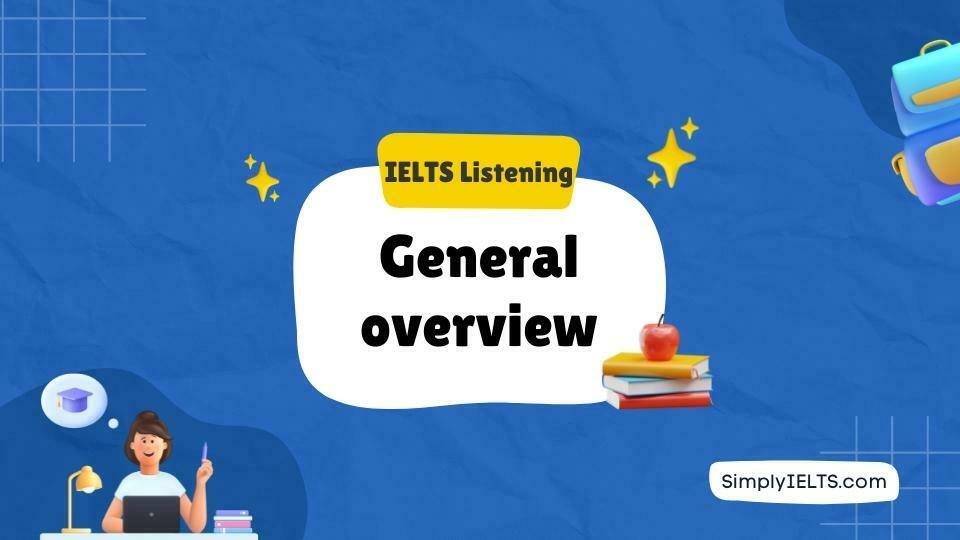General overview about IELTS Listening section

What is the IELTS Listening section?
The IELTS listening section is the first section that you would be attempting on your test day. A common opinion about this section is that it is much easier than the other sections in the exam. Some may go further and say that it is one of the most scoring sections. And I second that.
The reason for this popular opinion is because it is very predictable and almost fixed. You will hardly notice any changes. And the fixed format and predictability are your tickets to excel in IELTS Listening.
IELTS Listening section
Number of parts / audios on IELTS Listening = 4
Total number of questions on IELTS Listening = 40
Total time to listen and answer questions = 30 minutes
Time to transfer answers on paper-based IELTS = 10 minutes
Time to check answers on computer-delivered IELTS = 2 minutes
Format of IELTS Listening section
On your question paper, you will work with four parts with ten questions per part. Thereby, in total, you will answer 40 questions.
Overall, you spend approximately 30 minutes listening to the audio and answering the questions. This time may vary depending on the length of the audio, but it won’t go beyond 30 minutes.
As the whole process of answering the questions depends on the speed of the audio, you need not be concerned about time management in this section. Simply follow the audio and answer the questions.
How do I listen to these audios on the IELTS Listening section?
You would be listening to this audio either on a headset or a speaker system. It depends on the local centre.
It is good to plan to get used to either of them. You can even ask around to check what is the practice in the city where you are planning to give the test. And accordingly, opt for the headset or speakers right from the first day of your preparation.
On paper-based IELTS Listening section
While listening to the audio, you need to answer the questions on the question paper only. Later you will be asked to transfer the answers on the answer sheet in about 10 minutes.
The answer sheet is somewhat similar to what you can see on the screen. The answers are generally in the form of words, alphabets, or numbers. An answer can have a maximum of three words, so the space given is sufficient to write it.
On computer-delivered IELTS Listening section
Since you write your answers directly into blank, you are given only 2 minutes to check the answers. During this period, you should check the spelling and answer the un-attempted questions. You need not transfer your answers anywhere.
Answering questions on the IELTS Listening section
Follow the restrictions set by IELTS.
For each question type, IELTS declares a certain number of words and/or numbers you may use to write the answers. For example,
Write NO MORE THAN THREE WORDS AND/OR A NUMBER for each answer.
Since the above instruction clearly mentions you must not exceed three words, you may write a lesser number of words but not more than three. Also, you may use a number within your answers.
Can I write answers in capital letters on IELTS Listening?
The answers can be written in any case that is uppercase, lowercase, or a combination of them. We know that if a word is at the start of the sentence or is a proper noun, then the first alphabet should be a capital letter. However, this rule does not apply to this section. You can use any case that is upper or lower.
In the computer-based test, also, this convention is applicable.
Parts in IELTS Listening section
In the listening section, each part comprises either a conversation or a monologue. Thus, in total, you would be listening to four audios, but they are all part of one big audio. You cannot stop, forward, or rewind the audio during the exam.
Part 1 on IELTS Listening section
The audio in part 1 of the listening section will feature a conversation between two people. The purpose of the discussion is an enquiry about someplace or an event or services.
Part 2 on IELTS Listening section
The next part in the IELTS Listening section that is part 2 will be in the form of a monologue where you will hear a person describe features of a place or town. Sometimes you may also hear a person who is describing the changes made or are planned for a location or town.
Part 3 on IELTS Listening section
Part 3 is again a conversation between two students. It is a discussion where the students are deciding the action to be taken for their study or project. It could be a discussion where they are talking about how they completed their project in the past.
Part 4 on IELTS Listening section
The last part in the listening section is again a monologue by a professor. Most of the time, it is a lecture where the professor classifies the topic into sub-types and explains their features.
Following table summarises the four parts on the IELTS Listening section well.
| IELTS Listening Part | Audio Format | Purpose of the Audio |
| Part 1 | Conversation between two people | Enquiry |
| Part 2 | Monologue | Describe features of a place or the changes made at a location. |
| Part 3 | Discussion between two students | Decide the actions to be taken or that were taken for a study or project. |
| Part 4 | Monologue by a professor | Lecture on a topic classified into sub-types |
Types of questions on IELTS Listening section
There are a total of 6 question types in the listening section. However, not all appear in every part of the test.
Type 1: Form or note or table or flow-chart or summary Completion
You are required to fill in the gaps in a summary of part or of all of the listening audio. The outline will focus on the main ideas/facts in the speech. These ideas could depend on the kind of summary you are presented with as follows.
- If you are given a form you will often note factual details such as names of the people
- If you are given a set of notes you must summarise the given details using the layout to show how different items relate to one another
- If you are presented with a table to complete, you must summarise information which relates to clear categories such as place, time or price.
- Lastly, in case of a flow-chart complete a process which has clear stages, with the direction of the process shown by arrows.
You may have to select answers from a list on the question paper or find out the missing words from the recording.
Type 2: Short answer question
On this question type, you read a set of sentences summarising key details from all the listening text or one part of it. You then fill a gap in each sentence using information from the audio.
Since this question is very similar to the summary completion question, you may refer to the previous question type to learn about how to tackle this question type.
Type 3: Sentence Completion
On this type of question on the IELTS Listening section, read a question and then write a short answer using information from the audio. Sentence completion tests your ability to listen for concrete facts, such as places, prices or times, within the listening audio.
Type 4: Label the map or plan or a diagram
On this question type of you are presented with a plan of building or map of a town or even a diagram of equipment. You must label the submitted plan, chart or diagram using the information in the audio. Usually, you are offered a list of answers to choose from.
‘Label the map’ assesses the ability to comprehend the description of a place or a machine and relate it to a picture.
Type 5: Matching Features
Here, you must match a numbered list of items from the listening audio to a set of choices on the question paper.
Matching Features tests the skill of listening for information and whether a test taker can understand the details everyday conversations. It also examines your ability to follow a conversation between two people and recognise relationships between facts in the listening audios.
Type 6: Multiple Choice question
Multiple choice questions are asked to test a student’s ability to listen for details or relations in the information given in the audio. At the same time, your ability to weed out unnecessary information is also tested on this question type.
There are two subtypes of the multiple-choice questions offered on the IELTS Listening section.
Multiple choice question with a single answer
On this question type, each question is followed by three choices. You must listen to the audio and identify the correct answer. Not only that you must be able to eliminate the two wrong answer choices from the list of three and select the correct one.
IELTS Listening: MCQ
Multiple choice question with multiple responses
On this question type, you will see five answer choices after each question. You must select two correct answers out of them. For convenience, we like to call this question type as multiple response questions (MRQ).
Scoring on IELTS Listening section
The score awarded in listening is in the form of a band. It ranges from 0 to 9. The band is awarded based on the number of questions answered correctly. For instance, if your target score is eight-band in listening, then you need to answer 35 to 36 questions correctly—lesser the correct answers lesser the score. More the correct answers higher are the score.
Here is a chart showing the band you get based on the number of correct answers. You should note them down for future reference.
| Band Score | 9 | 8.5 | 8 | 7.5 | 7 | 6.5 | 6 |
| Score / 40 | 39-40 | 37-38 | 35-36 | 32-34 | 30-31 | 26-29 | 23-25 |
What is an incorrect answer on the IELTS Listening section?
Now, how is an answer termed as incorrect? If you choose incorrect options or words, then it is incorrect. However, if your choice of words or options is correct, but you did not follow the instructions or made a mistake while transferring then you would be penalised for it. There are various reasons for your answer to be incorrect as follows.
- Spelling Mistake
- Exceeding the word limit
- Incorrect form of a noun (Singular/Plural)
- Modified Answers
- Partial answers
- Repeating part of the question
I sincerely hope that you have understood the basic format of the Listening section. If you are already familiar with the question types and wish to improve your Listening skills and scores, you may like to check out the following article.





Responses